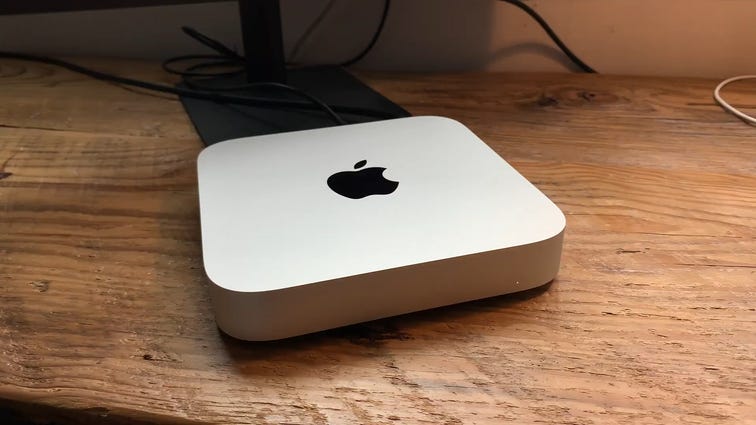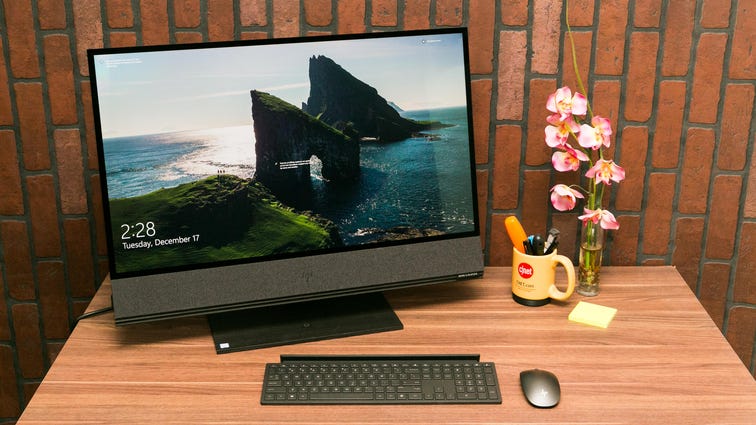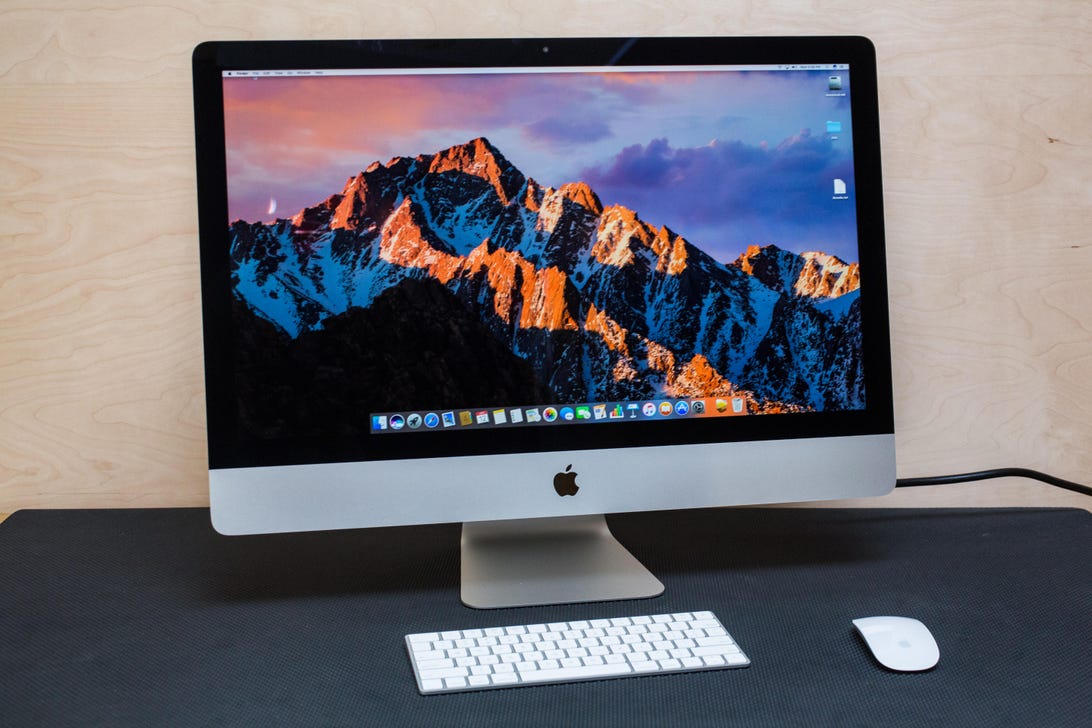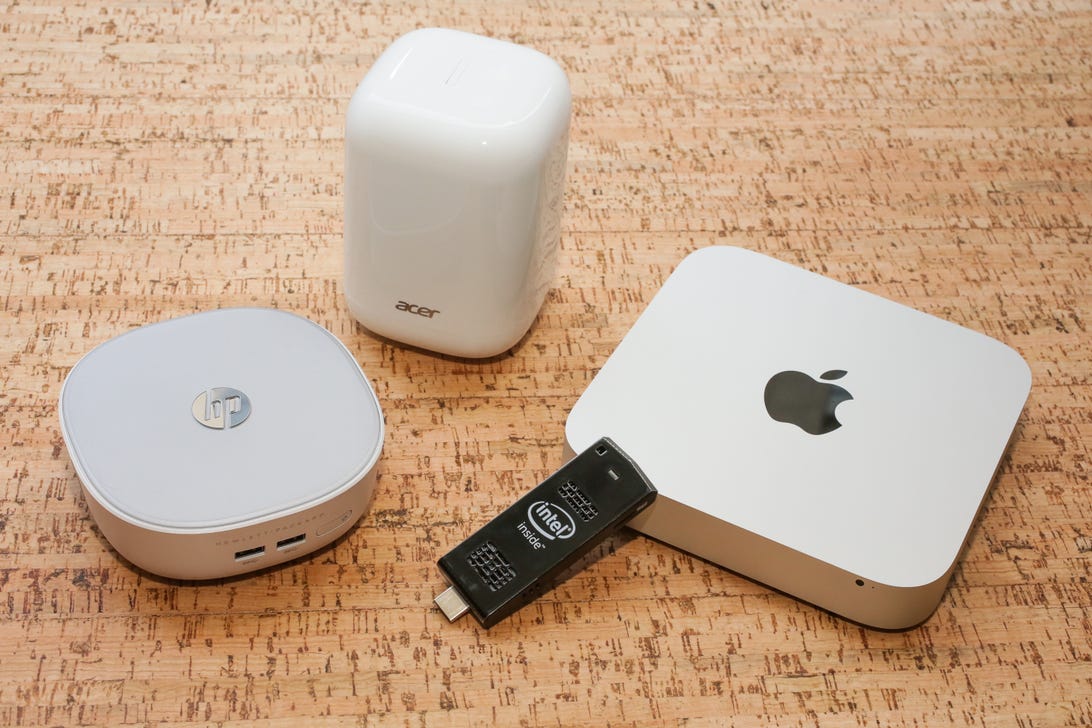Even though laptops and tablets make up roughly 80% of the PC market, one out of every five computers sold is a good old-fashioned desktop. And why not? If you already spend your day tethered to a big-screen monitor, a desktop PC as your home computer makes a lot of sense. And when it comes to longevity, it’s hard to beat a desktop PC. Plus, a desktop computer offers more power and expandability than a laptop, and a powerful processor, along with a quality hard drive or solid state drive for storage are especially important if you’ll be using your device for something like photo editing or as a gaming PC.
A desktop computer is generally going to come in the form of either a tower or an all-in-one (with an integrated screen), though there are smaller designs for tighter spaces. And while you can find Windows and Macs for as little as $500 to $700, Chrome and Linux fans have plenty of affordable options, too.
While laptops still occupy the majority of our editors’ time and effort with CNET’s hands-on reviews, we’ve rounded up recent products to bring you the very best desktop PC options, which are listed below. This list starts with models we’ve tested, and then moves on to more generic configurations. We haven’t explicitly tested those specific models in the latter batch, but the specs listed should deliver considerable value for the price, based on our experience with similarly configured laptops we’ve tested. Unless otherwise indicated, the products listed below don’t include a monitor, keyboard, mouse or webcam. You’ll need to bring your own or buy them separately. We update this best desktop PC list periodically.
Desktop PCs: Tested and recommended
These are the best desktop PC models that we’ve recently tested and can recommend based on our hands-on experience.

 \n ","topic":"","ttag":"","variant":"","viewguid":"","event":"listicle|image|1","correlationId":"","_destCat":"https:\/\/www.apple.com\/us-hed\/shop\/buy-mac\/imac","productName":"Sleek and speedy","formatType":"IMAGE","location":"LIST","position":1,"sku":"MGPK3LL\/A","dwLinkTag":"article-body|listicle|image","selector":"#article-body #listicle-86e1c8db-6776-4706-b466-f3dc856c8be2 .itemImage"}}” rel=”noopener nofollow” target=”_blank”>
\n ","topic":"","ttag":"","variant":"","viewguid":"","event":"listicle|image|1","correlationId":"","_destCat":"https:\/\/www.apple.com\/us-hed\/shop\/buy-mac\/imac","productName":"Sleek and speedy","formatType":"IMAGE","location":"LIST","position":1,"sku":"MGPK3LL\/A","dwLinkTag":"article-body|listicle|image","selector":"#article-body #listicle-86e1c8db-6776-4706-b466-f3dc856c8be2 .itemImage"}}” rel=”noopener nofollow” target=”_blank”>


Dan Ackerman/CNET
Apple has fully redesigned the iMac with a body so ultrathin that it could easily be confused with a jumbo-screen iPad. It’s now built on the same superfast M1 chip found in Apple’s late-2020 MacBook Air and Mac Mini (see below), with a gorgeous 24-inch screen replacing the previous 21.5-inch version. The 1080p webcam is a big upgrade over the MacBook’s 720p model, and the rainbow of available colors — hearkening back to the 1999 iMac G3 — is a welcome addition. Just be prepared to spend up for the myriad storage and accessory upgrades. (Note that the larger 27-inch iMac has yet to be revamped, and is still running an Intel processor.)

 \n ","topic":"","ttag":"","variant":"","viewguid":"","event":"listicle|image|2","correlationId":"","_destCat":"https:\/\/www.dell.com\/en-us\/member\/shop\/desktop-computers\/xps-8940-se-desktop\/spd\/xps-8940-se-desktop","productName":"Compact performance for gamers and creators","formatType":"IMAGE","location":"LIST","position":2,"sku":"","dwLinkTag":"article-body|listicle|image","selector":"#article-body #listicle-5cbb12d2-ed19-4500-a4ea-83045eed3a45 .itemImage"}}” rel=”noopener nofollow” target=”_blank”>
\n ","topic":"","ttag":"","variant":"","viewguid":"","event":"listicle|image|2","correlationId":"","_destCat":"https:\/\/www.dell.com\/en-us\/member\/shop\/desktop-computers\/xps-8940-se-desktop\/spd\/xps-8940-se-desktop","productName":"Compact performance for gamers and creators","formatType":"IMAGE","location":"LIST","position":2,"sku":"","dwLinkTag":"article-body|listicle|image","selector":"#article-body #listicle-5cbb12d2-ed19-4500-a4ea-83045eed3a45 .itemImage"}}” rel=”noopener nofollow” target=”_blank”>


Josh Goldman/CNET
While we like all-in-ones for their convenience, they’re not easy to upgrade, if they can be at all. Dell’s XPS Desktop is compact and quiet enough for a small workspace but can be loaded with an 11th-gen Core i9 processor, an Nvidia GeForce RTX 3070 graphics card, up to 64GB of memory and 4TB of storage — and there’s still room inside for more. And if you have modest needs now but want the room to add in components down the road, the base XPS starts at just $608. Want to spend a bit less? Check out the more affordable desktop computer options recommended further down the page.

 \n ","topic":"","ttag":"","variant":"","viewguid":"","event":"listicle|image|3","correlationId":"","_destCat":"https:\/\/www.amazon.com\/Apple-Mini-Chip-256GB-Storage\/dp\/B08N5PHB83\/","productName":"Affordable Mac upgrade","formatType":"IMAGE","location":"LIST","position":3,"sku":"","dwLinkTag":"article-body|listicle|image","selector":"#article-body #listicle-7c0db804-8a8d-4395-9b43-d1f8ff0f31af .itemImage"}}” rel=”noopener nofollow” target=”_blank”>
\n ","topic":"","ttag":"","variant":"","viewguid":"","event":"listicle|image|3","correlationId":"","_destCat":"https:\/\/www.amazon.com\/Apple-Mini-Chip-256GB-Storage\/dp\/B08N5PHB83\/","productName":"Affordable Mac upgrade","formatType":"IMAGE","location":"LIST","position":3,"sku":"","dwLinkTag":"article-body|listicle|image","selector":"#article-body #listicle-7c0db804-8a8d-4395-9b43-d1f8ff0f31af .itemImage"}}” rel=”noopener nofollow” target=”_blank”>


Dan Ackerman/CNET
If you’re looking for the most affordable Mac out there, the news is good nearly all around. Apple’s smallest desktop computer was among the first to get upgraded to the lightning-fast M1 processor, which runs rings around comparable Intel-powered Macs in terms of speed and performance. Unlike MacBook laptops, the Mini boasts legacy ports like USB-A and HDMI, too. The 256GB and 512GB models will run you $699 and $899, respectively, at the Apple Store, but the good news is that they’re now frequently on sale at other retailers for $50 to $100 less. More and more Mac apps are adding compatibility for the M1 platform, and Apple’s Rosetta 2 software runs most legacy apps in a fairly speedy compatibility mode, but if you still want native Intel support, a Core i5 version of the Mini remains in the line for $1,099.

 \n ","topic":"","ttag":"","variant":"","viewguid":"","event":"listicle|image|4","correlationId":"","_destCat":"https:\/\/www.amazon.com\/HP-Processor-graphics-32-a0040-6YR48AA\/dp\/B083GHHTH1","productName":"Jumbo screen all-in-one","formatType":"IMAGE","location":"LIST","position":4,"sku":"","dwLinkTag":"article-body|listicle|image","selector":"#article-body #listicle-a528efad-3e9b-48d1-99d7-e84b69d71425 .itemImage"}}” rel=”noopener nofollow” target=”_blank”>
\n ","topic":"","ttag":"","variant":"","viewguid":"","event":"listicle|image|4","correlationId":"","_destCat":"https:\/\/www.amazon.com\/HP-Processor-graphics-32-a0040-6YR48AA\/dp\/B083GHHTH1","productName":"Jumbo screen all-in-one","formatType":"IMAGE","location":"LIST","position":4,"sku":"","dwLinkTag":"article-body|listicle|image","selector":"#article-body #listicle-a528efad-3e9b-48d1-99d7-e84b69d71425 .itemImage"}}” rel=”noopener nofollow” target=”_blank”>


Sarah Tew/CNET
This Windows take on the basic iMac design hit stores in early 2020, and it shows in its somewhat dated specs: a ninth-gen Intel CPU and a spinning hard drive backing up the 256GB solid-state drive. That said, you get a gigantic 32-inch 4K display powered by an integrated Nvidia GTX 1650 video card (which can handle some decent games) in a reasonably attractive package. We’d like to see a refresh with newer internals, but in the meantime, you’d be hard-pressed to find an all-in-one with a bigger screen than these HP desktops.

 \n ","topic":"Desktops","ttag":"ir","variant":"","viewguid":"","event":"listicle|image|5","correlationId":"","assettitle":"","campaign":"ir","cval":10,"leadCpc":0.1,"leadProdPrice":3899,"manufacturer":"Microsoft","productName":"Microsoft Surface Studio 2","seriesGuid":"1384946b-a07e-43a6-82af-bf77a439a581","sku":"LAH-00001","reviewId":"8e071680-a566-454c-ac2d-e632a5fd5c16","formatType":"IMAGE","location":"LIST","position":5,"dwLinkTag":"article-body|listicle|image","selector":"#article-body #listicle-e8d23ee5-8ba4-4f0b-8f9d-fdde1c7304fb .itemImage"}}” rel=”noopener nofollow” target=”_blank”>
\n ","topic":"Desktops","ttag":"ir","variant":"","viewguid":"","event":"listicle|image|5","correlationId":"","assettitle":"","campaign":"ir","cval":10,"leadCpc":0.1,"leadProdPrice":3899,"manufacturer":"Microsoft","productName":"Microsoft Surface Studio 2","seriesGuid":"1384946b-a07e-43a6-82af-bf77a439a581","sku":"LAH-00001","reviewId":"8e071680-a566-454c-ac2d-e632a5fd5c16","formatType":"IMAGE","location":"LIST","position":5,"dwLinkTag":"article-body|listicle|image","selector":"#article-body #listicle-e8d23ee5-8ba4-4f0b-8f9d-fdde1c7304fb .itemImage"}}” rel=”noopener nofollow” target=”_blank”>


Sarah Tew/CNET
What if the iMac had support for touchscreen and stylus input? That’s basically the pitch for Microsoft’s Surface Studio 2, a Windows-powered all-in-one that seals the deal for artists with its ability to tilt the 28-inch screen back like a drafting table. The original model was woefully underpowered, and the latest model still doesn’t deliver all the bells and whistles we’d expect at this lofty price, but its unique design may have you overlooking those flaws and reaching for your credit card anyway.
Other recommended desktop PCs
We haven’t reviewed the specific models below, but we have reviewed systems using very similar hardware. These general configurations should serve you well, especially if you shop around for frequent deals.
Basic Windows PC tower (starting around $620)
The specs we’d suggest for a basic Windows 10 machine:
- Intel Core i5 (9th-, 10th-gen) or AMD Ryzen 5 (3000 or 5000 series)
- Default integrated graphics (such as Intel 630 or baseline AMD Radeon)
- 512GB or larger NVMe SSD drive
- 12GB of RAM or more (16GB preferred)
- Four or more USB 3.1 / 3.2 ports with USB-C and USB-A formats (at least one or two on the front)
- Wi-Fi and Bluetooth wireless
- At least one PCI-E (x16) expansion slot (for adding a video card)
- A DVD or Blu-ray optical drive (if you need it for legacy software or media)
With those specs in mind, you should be able to find a good PC tower from brands like Dell, Acer, Asus or HP for between $500 and $600. Here are some that fit the bill, offering a great bang for the buck if you don’t need a laptop:
Acer TC-895-UA92 ($669)
This 10th-gen Intel Core i5 configuration includes everything listed above, along with Wi-Fi 6 compatibility and a keyboard and mouse, too.
HP Pavilion Desktop TP01-1140 ($620)
This system offers a capable AMD Ryzen 5 CPU, and HP throws in a mouse and keyboard.
PC tower for light gaming and creative duties (starting around $900)
Want to do some PC gaming, or do you spend time editing photos or video? You’ll want to level up the above configuration with more RAM and better graphics options. Expect price points to be between $800 and $1,200 — and even higher if you go for a more bleeding-edge video card.
- Nvidia GTX/RTX or AMD Radeon RX graphics card (GPU)
- 16GB of RAM or more
- 350-watt (or more) power supply
Looking for a gaming computer with more muscle? Check out our list of best gaming PCs.
HP Pavilion Gaming Desktop TG01-1076z ($900)
This HP rig boasts an AMD Ryzen 5 CPU and Nvidia GeForce GTX 1650 GPU, a 400-watt power supply, 16GB of RAM and tosses a 1TB spinning hard drive on top of the 512GB SSD. Base price is $900, but we’ve seen it on sale for as low as $750. (This was out of stock when we last checked.)
Dell G5 gaming desktop tower ($1,390)
This Dell model has nearly the same specs as the HP above, but with a 10th-gen Intel Core i5 in place of the AMD Ryzen. We’d previously seen this for $1,050, but it appears to be currently selling for closer to $1,400. (We’ve seen it hit as low as $750.)
Basic Windows All-in-One (starts around $800)
An “all-in-one PC” (also known as AIO PC) is basically a Windows version of an iMac. That means the PC “guts” are essentially built into a monitor or its base. Unlike the PC towers listed above, all-in-ones generally offer no ability to upgrade the graphics card, and maybe not even the storage or RAM. The advantage is having fewer cables, however, since everything is integrated into the body.
Recommended specs for an all-in-one are mostly similar to the basic tower above, albeit with compromises because of space considerations. Don’t expect an optical drive, for instance, and know that performance is often a step down from “real” desktop models because some all-in-ones use laptop components to better maximize available space. You’ll want a large screen with good resolution. The sweet spots we’d suggest are:
- 24 inches at 1,920×1,080 (aka 2K or 1080p)
- 27 inches at 2,560×1,440 (aka 1440p)
- 32 inches at 3,840×2,160 (aka 4K)
The 24-inchers are good for kids, but adults should probably go for 27 inches and up. Expect to pay at least $800 at that latter size, especially if you want to avoid underpowered Intel Core i3 or AMD Athlon CPUs. The Surface Studio 2, HP Envy 32 (above) and Apple iMacs (below) are examples of high end all-in-one computers, but here’s a more reasonably priced alternative.
Acer Aspire C27-962-UA91 ($800)
While the screen on this Acer Aspire model is a spacious 27 inches, resolution is only 1080p (also known as 2K) — but that’s par for the course below the $1,000 price point. This model also lacks a DVD drive and USB-C ports. That said, you get a 10th-gen Intel Core i5 CPU, on-board Nvidia MX graphics (not as good as a GTX or RTX card, but better than average), half a terabyte of SSD storage and a built-in webcam (along with a keyboard and mouse).
What about an iMac 27-inch or Mac Pro?

The current iMacs still run Intel chips. Faster M1 versions are on the way, and worth waiting for most people.
Sarah Tew/CNETWhile you’re paying a big premium for the Apple name, an iMac is generally a great option for Apple fans who want an all-in-one computer with a superior display. And now that the 24-inch iMac has gotten a fresh overhaul, complete with the M1 chip, that’s a great starting point (see above).
Looking for other Mac desktop options? That’s a bigger challenge. The iMac Pro was recently discontinued by Apple, and the 27-inch (non-Pro) iMac has yet to get its Apple silicon upgrade, so it remains available with older Intel chips.
As for the Mac Pro: It offers serious workstation-level performance, but with an entry price point of $6,000, it’s effectively for pro users only. Meanwhile, the hardware — which debuted in late 2019 — runs on an Intel platform, which Apple is now moving away from with its aforementioned Apple silicon chips. Here, too, rumors of a “Mac Pro Mini” (Apple silicon CPU inside a smaller chassis with fewer, if any, internal expansion slots) mean that waiting is the prudent option here, as Apple has pledged to complete its transition away from Intel before the end of 2022.
Chromebox, Mini PCs and other niche options
When it comes to desktop PCs, towers and all-in-ones represent the vast majority of the market. There are alternatives, but in the 2020s, they generally represent increasingly narrow slices of that market.


Left to right: The HP Mini, Acer Revo, Intel Compute Stick and Apple Mac Mini. The Mac is the only one that’s been recently updated.
Sarah Tew/CNETMini PCs: Following the debut of the Mac Mini in 2005, Windows PC makers experimented with similarly tiny designs. In the wake of likable small models like the Acer Revo One and HP Pavilion Mini, we even saw (woefully underpowered) “PC on a stick” offerings starting in 2015, but interest seems to have ebbed since then. Outside of specialty vendors like Beelink, the best choices in this mini PC size are probably the Intel NUC (Next Unit of Computing), most of which are sold as hobbyist options, requiring some BYO additions like user-supplied storage, RAM and other components — including the operating system. See more bare-bones Mini PCs at Newegg.
Chromeboxes: If you’re looking for very basic computing — browsing the web, email, social media, YouTube and the like — the Chrome operating system is the most affordable route for home computing. This Google operating system effectively is little more than the Chrome web browser. That makes it easy for multiple users (only a Gmail address is needed to log in), and — because there’s no heavy operating system beyond the browser — viruses aren’t really an issue. Colloquially known as “Chromeboxes” (versus a “Chromebook” laptop), these systems don’t have beefy CPUs, RAM or storage requirements. That said, if you need any software beyond browser-based web apps, or if you don’t have excellent broadband, you’ll want to stick with Windows or Mac options above. Expect to pay between $200 and $500 for a Chrome-based desktop. But the closer you get to that $500 price point, the more you should consider stepping up to a Chromebook laptop or a basic Windows tower (see above) for just a bit more. See Chromebox options at Amazon.
Linux PCs: No, Windows, Mac and ChromeOS are not your only operating system options. There’s a wide world of Linux operating systems out there, many of which are effectively free. You can get PCs with Linux preinstalled, but the better, more affordable option is probably installing it (or dual-booting) on a used Windows PC. Another option is the Endless Mission PCs, which cost between $79 and $229 and run a custom Linux-based OS.
Raspberry Pi: You may have heard of a small computer that’s no bigger than a paperback book, and can be had for about $150. That’s the Raspberry Pi, and it’s 100 percent real and very cool — if you’re a hobbyist looking to build your own Lego-style computer and install your own custom Linux operating systems. We just wouldn’t recommend it as a primary computer if you’re looking to run mainstream software. See the Raspberry Pi 4 kit at Amazon.